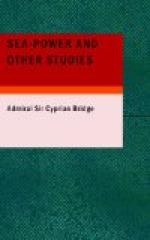My object is to present the results of an inquiry into the history of the relations between the navy and the merchant service, from which will appear to what extent the latter helped in bringing the former up to a war footing, how far its assistance was affected by the presence in it of any foreign element, and in what way impressment ensured or expedited the rendering of the assistance. The inquiry has necessarily been largely statistical; consequently the results will often be given in a statistical form. This has the great advantage of removing the conclusions arrived at from the domain of mere opinion into that of admitted fact. The statistics used are those which have not been, and are not likely to be, questioned. It is desirable that this should be understood, because official figures have not always commanded universal assent. Lord Brougham, speaking in the House of Lords in 1849 of tables issued by the Board of Trade, said that a lively impression prevailed ‘that they could prove anything and everything’; and in connection with them he adopted some unnamed person’s remark, ’Give me half an hour and the run of the multiplication table and I’ll engage to payoff the National Debt.’ In this inquiry there has been no occasion to use figures relating to the time of Lord Brougham’s observations. We will take the last three great maritime wars in which our country has been engaged. These were: the war of American Independence, the war with Revolutionary France to the Peace of Amiens, and the war with Napoleon. The period covered by these three contests roughly corresponds to the last quarter of the eighteenth and the first fifteen years of the nineteenth century. In each of the three wars there was a sudden and large addition to the number of seamen in the navy; and in each there were considerable annual increases as the struggle continued. It must be understood that we shall deal with the case of seamen only; the figures, which also were large, relating to the marines not being included in our survey because it has never been contended that their corps looked to the merchant service for any appreciable proportion of its recruits. In taking note of the increase of seamen voted for any year it will be necessary to make allowance also for the ‘waste’ of the previous year. The waste, even in the latter part of the last century, was large. Commander Robinson, in his valuable work, ‘The British Fleet,’ gives details showing that the waste during the Seven Years’ war was so great as to be truly shocking. In 1895 Lord Brassey (NavalAnnual_) allowed for the personnel of the navy, even in these days of peace and advanced sanitary science, a yearly waste of 5 per cent., a percentage which is, I expect, rather lower than that officially accepted. We may take it as certain that, during the three serious wars above named, the annual waste was never less than 6 per cent. This is, perhaps, to put it too low; but it is better to understate the case than to appear to exaggerate it. The recruiting demand, therefore, for a year of increased armament will be the sum of the increase in men plus the waste on the previous year’s numbers.




